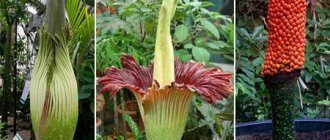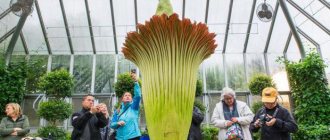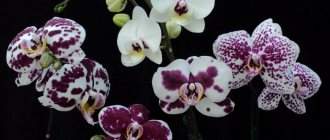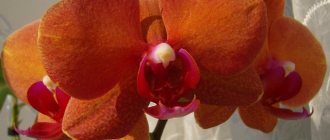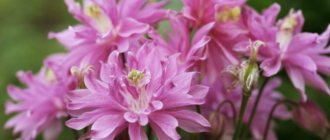Amorphophallus is a very unusual and interesting exotic plant, which in its natural environment grows in the tropical and subtropical zone, from West Africa to the Pacific Islands, in Cambodia, Indonesia, Malaysia, the Philippines, and Sri Lanka. It grows in nature in various places and is not particularly picky in choosing the soil and place of growth. The genus belongs to the Araceae family (Araceae, Arum) and is quite wide and diverse and includes more than 100 plant species, which range from small to giant. Amorphophallus are tuberous herbs that have a dormant period, but there are also evergreen specimens in its genus. The size of the tuber varies and can reach a weight of 5 kilograms.
The name of this exotic genus comes from two Greek words μορφος, “formless,” and φαλλός, “phallus, shoot, offspring.” In various countries, Amorphophallus is popularly called “Voodoo Lily”, “Snake Palm”, “Corpse Flower”, “Devil Flower”. It cannot be said that these names have nothing behind them, because when Amorphophallus blooms it emits a very unpleasant smell, but the main thing is to hold out for the first 3 days, then the smell weakens and soon disappears completely. In nature, this smell serves as a bait for insects, which serve as a pollination tool.
In nature, female flowers open earlier than male ones, and for pollination it is necessary for two plants to bloom almost simultaneously, with a difference of 2-3 days. If pollination has occurred, then in place of the flower a cluster of fleshy berries with seeds is formed, and the mother plant dies. Under indoor conditions, none of the cultivated species produces seeds.
Amorphophallus: characteristics
Amorphophallus means “shapeless” in Greek and belongs to the Araceae family, which includes more than 170 plant species. Titan arum (Amorphophallus titanica is the world's largest inflorescence, belongs to this genus. It can reach a height of 2.5 m and a width of 1.5 m. In second place is Amorphophallus gigas, which is taller, but has a slightly smaller flower.
Amorphophallus is a typical lowland plant, growing in tropical and subtropical zones, from West Africa to the Pacific Islands. Most species of amorphophallus are endemic. They grow mainly on disturbed grounds, such as secondary forests, but are also found on rocks (on limestone soil) and in weedy places.
These plants come in different sizes, from small to giant. They grow from underground tubers the size of grapefruits and weighing about 5 kg, some from rhizomes or stolons. These plants have a dormant period, some of them are evergreens.
The tuber is compressed-spherical in shape, sometimes unevenly cylindrically elongated, turnip-shaped or cone-shaped. It is from this that the plant develops. In some species, the tuber reaches a weight of 90 kg. The tuber remains dormant for about six months. A thick shoot emerges from the tuber, powerful and strong. The same impressive leaf, dissected along the edges, extends from it. When grown as amorphophallus at home, the leaf unfurls in April. It will be deployed until October. After which it turns yellow and dies. This indicates a dormant period for the plant. In spring, a new leaf appears, larger, more powerful and stronger than the previous one.
Three periods of flowering of amorphophallus: bud, flower, fruit
Flowering of amorphophallus is short-lived. It lasts about 14 days. During this period, the tuber seems to shrink and decrease in size. All its nutrients are used to maintain the flower. After flowering, the plant recovers within a month. Then it produces a new sheet.
If the plant is accidentally pollinated, then fruits containing seeds are formed in the lower part of the cob. After the fruit is fully ripe, the flower dies. As a rule, pollination occurs only in natural conditions; flowers are rarely pollinated at home. For pollination to occur, at least two plants must bloom nearby.
How and how long does amorphophallus bloom?
Amorphophallus flower at home photo of flowering
A large tuber grows and develops in the soil, reaching a weight of 5 kg, and in appearance it looks like a grapefruit. With the beginning of active growth, a stem appears from it - it is thick and green. A tripartite, double pinnately dissected leaf plate grows at the top; its length is about half a meter, the petiole is hollow. The leaf will “live” for about 6 months: it will appear at the end of March, and by mid-October it will turn yellow and wither. The leaves are greenish-brown with whitish speckles. Each subsequent leaf grows a little higher than the previous one and will be more dissected. A semblance of a palm tree is created.
The peduncle appears after a dormant period even before the leaves grow. Flowering lasts about 15-20 days. After this, the plant will give new roots, the tuber itself will significantly decrease in size, since the phase of active growth and flowering takes a lot of energy. When flowering ends, the amorphophallus will “fall asleep” again for about a month. After this, a new leaf plate will grow. It happens that after flowering the plant remains dormant for about a year (until next spring).
If pollination occurs, infructescence will form - fleshy berries filled with seeds. After fruiting, the plant dies. It’s good that male flowers most often bloom later than female ones; self-pollination occurs extremely rarely. Pollination is possible if at least a couple of plants bloom at the same time. Here is such a mysterious amorphophallus.
Amorphophallus: soil
The flower is very picky about soil. It needs rich, nutritious soil with a slightly acidic reaction, with a large proportion of sand and good drainage. It should consist of 2 parts humus, 1 part turf soil, 1 part sand. After a dormant period, the tubers are planted in the ground only after the apical bud begins to grow. Some types of plants require the inclusion of clay. This is due to the nature of the habitat of these species. These include varieties:
- A. muelleri;
- A. paeoniifolius;
- A. prainii.
Amorphophallus is quite unpretentious, but if the soil is too dense, its roots begin to rot. Therefore, the mixture for this flower should be loose and allow air to pass through well.
On a note !!!
To enrich the soil with nutrients, dolomite flour is added to it. To create looseness, the soil is mixed with vermiculite and moss (sphagnum).
Variety of sizes and unusual aroma
The size of the plant is very variable - from a tiny flowerpot to over 2 meters. Amorphophallus is considered one of the best air fresheners; its phytoncides have proven bactericidal properties. It can easily cope with exhaust gases; the leaves actively absorb carbon oxides, formaldehyde, and various phenolic and benzene compounds.
Amorphophallus in different growing zones is called “devil/corpse flower”, “voodoo lily”, and other not very attractive names.
Such shocking epithets are associated with the ambiguous aroma that the amorphophallus flower exudes: it is really similar to the smell of rotten fish, meat or garbage, or even a corpse. However, it is noticeable only on plantations or in greenhouses where seedlings are grown.
You need to smell a flowerpot very well to feel something. Therefore, there are not so few lovers of the beauty of this flower; photos of amorphophallus can often be seen in the portfolios of professional flower growers and on Instagram of lovers of tropical plants.
Amorphophallus: temperature
Amorphophallus tolerates room temperatures of 22–25 °C. Does not feel discomfort even at 19°C. During the dormant period it prefers 10-13°C.
On a note!!!
Not all types of amorphophallus adapt well to the home environment. For example, Japanese amorphallus kiusianus does not tolerate hot air and a temperature of 25°C is critical for it. The plant begins to lose foliage and color. In contrast to this variety, amorphophallus bulbifer grows well not only at room temperature, but also at 15–30 °C.
Amorphophallus: watering and air humidity
Amorphophallus prefers high air humidity. Therefore, it should be well watered. In this case, water should not touch the tuber to avoid rotting. For the same reason, the plant should be provided with good drainage. All excess water should not stagnate in the pot, but should drain into the pan. After 30 minutes, when the soil is completely saturated with moisture, the water is poured out of the pan.
Photo of amorphophallus
During growth, the plant is watered abundantly, avoiding water getting on the tuber. After the leaves wilt, watering is limited.
To protect the flower from rotting, you do not need to pour water on the tubers. In autumn, when the leaves begin to fade, the amorphophallus is dormant and needs less water. By winter, watering is completely stopped.
An indoor flower should be regularly sprayed with water. In the summer, this is done daily to create a moist environment around the plant that is close to natural living conditions.
Important!!!
The leaves of Amorphophallus do not allow moisture to pass through, which is why the flower needs high air humidity, which should be more than 60%. In addition, the plant does not like dust, so its leaves should be wiped regularly.
About caring for Amorphophallus:
Temperature: The optimal temperature for Amorphophallus in summer is 23-25 ºC, and in winter the temperature should not fall below 10 ºC.
Lighting: Amorphophallus needs bright, diffused lighting and does not tolerate direct sunlight, this can cause leaf burns.
Watering: Amorphophallus needs regular and abundant watering. It is necessary to water with soft, settled water. It is necessary to water carefully so that water does not fall on the plant tuber, this can lead to rotting. The frequency of watering depends on the temperature of the content. In summer, the plant has active growth and an increased need for water, as the soil dries out faster. In autumn, when the dormant period approaches, watering is gradually reduced. The water from the pan must be drained half an hour after watering. Excessive waterlogging and overdrying are dangerous for the plant. In winter there is a period of rest. All watering should be stopped.
Amorphophallus bulbifer.
Air humidity: Amorphophallus prefers high air humidity. A daily procedure for her should be light, fog-like spraying of the leaves twice a day in the morning and evening with soft, settled water, especially in the summer. Spraying in hot weather has a beneficial effect on the plant. It is advisable to regularly clean the leaves from dust and periodically give the plant a shower.
Fertilizers : It is necessary to fertilize Amorphophallus during the period of active growth, as soon as the sprout appears, from spring to autumn 2 times a month with fertilizer with a high phosphorus content. With a lack of phosphorus, the tuber is depleted and slowly gains nutrients for flowering. It is necessary to alternate mineral fertilizer (nitrogen, phosphorus, potassium) with organic fertilizer. In the case of Amorphophallus, you cannot neglect fertilizer; this is an essential part of caring for it.
Soil: The Amorphophallus tuber must be planted in soil that must be nutritious. Suitable soil for decorative foliage plants, a universal substrate. It is recommended to add humus and charcoal to the substrate. You can make it yourself from peat, sand and leaf soil in a ratio of 1:1:2. Good drainage at the bottom of the pot is necessary.
Transplantation: Occurs once a year in the spring, when the plant emerges from the dormant period in accordance with the growth of the tuber.
Pests of Amorphophallus. Considered pest resistant. Major problems can only arise as a result of improper care of the plant during the period of active growth and during the dormant period. A young plant can be affected by spider mites and aphids.
Amorphophallus: feeding
After germination of fresh seedlings, amorphophallus is fed once every two weeks with organic and mineral fertilizers, alternating them. It should be taken into account that amorphophallus needs a fairly large dose of phosphorus. To quickly increase the mass of the tuber, it is necessary to regularly fertilize the plants, maintaining the ratio of nitrogen, phosphorus and potassium in the ratio 1:3:2 or even 1:4:1. Agricola and Ideal are good for feeding. These fertilizers can be combined with double superphosphate. For 1 tsp. The drug Agricola should take a teaspoon of double superphosphate. This amount of the drug is designed for 3 liters of water.
Fertilizers for amorphophallus
For large tubers, one part of humus can be added to the standard substrate for aroids. It is recommended to water the soil in the pot abundantly before fertilizing.
Attention!!!
The plant is fed immediately after watering. It is not recommended to apply fertilizer if the plant is damaged, sick or has recently been transplanted.
Amorphophallus: dormant period
Amorphophallus is a plant with an obligatory dormant period. In winter it loses its leaves. At this time, it is better to place it in pots in a cool, dark place and periodically moisten it. In the spring, at the end of March, the tubers are planted in larger pots. When a tuber rots, it is removed from the pot and the rotten part is cut off with a sharp knife, the cut is treated with crushed charcoal, and placed to dry for a day. After this, the plant can be planted in a new soil mixture.
Many gardeners recommend not storing tubers in a substrate. When the leaf withers, you need to carefully knock the tubers out of the pot, clean them of soil, carefully examine them, and separate the daughter tubers. If necessary, remove rotting areas and dead roots with a sharp knife, then rinse the wounds with a strong solution of potassium permanganate and place the tubers in a dry, dark and warm place.
Amorphophallus: transplantation and planting
Both transplantation and planting of amorphophallus are carried out during the dormant period. The tuber is planted when young shoots appear. As a rule, this happens in the third ten days of February or early spring.
Plant the tuber in a pot that is twice the size of the tuber. In order for the formation and development of the root system to proceed normally, you should choose a deep container. Drainage is placed at the bottom of the pot. It should occupy 2-3 cm. It can be expanded clay, crushed brick or pebbles. The acidity of the soil should be weak or neutral.
For amorphophallus, ready-made soil intended for aroid plants is suitable. You can prepare the soil mixture yourself. The most suitable soil would be a soil consisting of leaf soil, turf, humus, peat or coconut substrate and sand. All components must be thoroughly mixed together.
To plant a houseplant you need:
- Cover the drainage with a layer of 2-3 cm.
- Place the tuber in the pot, with the shoots facing up.
- Sprinkle with soil so that the sprouts are above the ground and about 7-8 cm to the edge of the pot.
- Compact the soil a little.
- Gently water the tuber with soft and settled water. Care should be taken to ensure that water does not get on the tuber itself.
- Place the pot in a well-lit place, but out of direct sunlight.
Attention!!!
During the formation of the peduncle, it is better not to disturb the amorphophallus. If the pot for the plant is too small and this interferes with the full formation of the root system, then you can carefully replant the flower using the transshipment method.
The peculiarity of the amorphophallus tuber is the formation of a thickened stem in the seedling; the next year a leaf appears on this tuber and a new tuber, larger, is immediately formed, but the first one does not separate. With age, quite a lot of daughter tubers (children) are formed. Reproduction by children (this operation is done in the fall): after the leaf dies, the tuber is removed from the pot, the children are collected and stored until spring in a bag with slightly moistened peat (it should crumble when squeezed in your hand). The bag with the babies is tied and placed in a cool place. In the spring, the children are planted in the soil mixture.
The main life cycles of a plant by season:
SPRING: Since the end of March, your plant has left the dormant period, so you should plant the tuber in a pot, which should be 3 times larger than the tuber. The tuber is planted with its growth point upward, it is slightly enlarged. Small specimens may not have it, so you must immediately ask the seller on the spot. Remember that the plant is quite heavy, so the pot you choose must be stable. Each year the tuber becomes larger, accumulating nutrients for flowering. The larger the tuber, the more gorgeous its flowering will be. At home, this happens on average once every 3 years. The sprout of Amorphophallus will appear quite quickly and is characterized by fairly rapid growth. A single leaf or tree grows from the tuber until mid-October, which then dies. Each new year the leaf becomes larger and more dissected. At this time, it must be actively fertilized in order for the active growth of the tuber to occur.
Amorphophallus konjac.
SUMMER: The active growth phase of your plant, either a tree or an inflorescence has already formed from it. If this is a tree, then care should include abundant watering and spraying. If your Amorphophallus is 5 or more years old, then instead of a tree it will delight you with flowering with an unforgettable aroma. Flowering of Amorphophallus occurs after a period of dormancy until a new leaf appears. Flowering is always single and occurs on a petiole, which can vary in size. Amorphophallus blooms on average for 2 months, but during this not so long period the plant tuber becomes lighter, as a lot of nutrients are consumed. If after flowering there are nutrients left in the tuber, then the tree will grow again, and if not, then the plant will retire prematurely until the new spring. Therefore, every year the plant must be actively fertilized, since the tuber accumulates nutrients in order to bloom one day.
AUTUMN and WINTER: Time for the plant to go dormant. The leaves dry out and fall off. Watering is reduced. When the plant dries out completely, watering should be reduced. The pot with the tuber is placed in a cool place where the temperature is not lower than 10 °C. During the dormant period, all watering stops. The first watering occurs when a new shoot appears in the spring. Just during the dormant period, in winter, the sale of tubers in stores begins; they are stored in the refrigerator in the vegetable department until spring.
Amorphophallus: reproduction
Amorphophallus reproduces by children, by dividing the tuber and by seeds. Each reproduction method has its own advantages and disadvantages.
Reproduction of amorphophallus
Amorphophallus: reproduction by children
Amorphophallus usually reproduces by children. When a plant's leaf begins to wilt, the plant enters a dormant period. At this time, you should remove the plant from the ground, clean the tubers from the soil and separate the daughter ones. They are stored all winter in a warm (10-15°C), dry and shaded room. Tubers are planted in March-April.
Reproduction and development of amorphophallus
Amorphophallus: tuber propagation
In addition, the tuber can be divided. However, for this to happen, the tuber must have sprouted buds, and when dividing the tuber, each separated part must contain one such bud. Cut carefully so as not to damage the buds. Treat the cut areas with charcoal and dry for 24 hours. Then plant in the ground, water carefully at first.
Reproduction of amorphophallus
Amorphophallus from seeds
In rare cases, propagation by seeds is possible; they are sown in the spring, at a temperature of 2-3 degrees Celsius. Plants from seeds bloom five years after planting.
Amorphophallus diseases and pests
At home, amorphophallus almost does not suffer from pests and diseases. True, young tender leaves of delenok and children are damaged by aphids and spider mites. Sometimes pests can also damage adult plants. With severe damage, adult specimens experience premature leaf shedding.
Spider mites appear when the indoor air is too dry. In this case, the surface of the leaf becomes covered with white spots. And at the bottom of the leaf, upon careful examination, you can see small mites and cobwebs. To prevent the appearance of spider mites, you need to humidify the air.
Fitoverm will help you defeat mites and aphids. The plant should be treated with it twice a day. After 10 days, the procedure should be repeated.
If the plant is flooded, waterlogging of the soil can cause midges to appear. In this case, only the soil is treated with Fitoverm, without touching the plant.
Drying out the soil and lack of light can cause partial drying of the leaf. Under conditions of moderate lack of light, the amorphophallus leaf changes color - it becomes more contrasting, dark green with red edges.
Amorphophallus: types
The genus Amorphophallus includes over 100 species, but only a few of them are unusual and popular among modern gardeners.
Amorphophallus bulbifer
A plant with one leaf reaching 1.5 meters in length. Small tubers form at the very base of the blade and at the top of the petiole. The petal (veil) of amorphophallus bulbiferous reaches 20 cm in length, has a greenish color interspersed with pink spots, it is greenish-yellow inside and red at the base. The inflorescence stem grows 30 centimeters in height. This type of amorphophallus grows in the monsoon forests of Eastern India and Burma.
Amorphophallus bulbous
Amorphophallus konjac
A corm plant with one single leaf up to 1 m high (appears after flowering), a peduncle 70 cm high, its inflorescence consists of a spadix and a spathe, which is twice as long as the spadix. It is used as an ornamental despite the disgusting smell emitted by the plant during flowering.
Amorphophallus cognac
Amorphophallus campanulatus
A plant with round tubers reaching 30 cm in diameter. It has tripartite leaves. The petal is almost four times longer than the stem and is purple-violet in color. The homeland of Amorphophallus campanulata is Fiji, the islands of New Guinea, the Philippines, and Sri Lanka.
Amorphophallus campanulate
Amorphophallus rivieri Durieu
A plant with large tubers (up to 30 cm in diameter). The single broad umbrella leaf reaches 1 meter in length. The plant has a green petiole with a whitish or brown pattern. The bedspread is 30 cm long, glossy, tubular at the base, dark purple in color. In the upper part, the inflorescence grows up to 30 cm in length and has a rich black-violet color. Amorphophallus Rivera blooms, but rarely bears fruit.
Amorphophallus rivera
Amorphophallus titanum
The tubers of this plant have an impressive size - up to 50 cm in diameter and weigh up to 23 kilograms. Its leaf is huge, up to 3 meters in diameter, forked-pinnate, tripartite. The petiole is up to 5 meters long and 10 cm thick, has a matte green color with a small number of white transverse stripes.
Amorphophallus titanium
Petal 70-80 cm long, green outside, brownish-purple inside. It grows in the monsoon forests of the island of Sumatra. This exotic plant of gigantic size is not found in indoor culture.
Amazing Amorphophallus konjac - growing at home
Amorphophallus cognac bloomed in the Botanical Garden "Apothecary Garden"
. Not everyone will be able to look at a rare flower and inhale its suffocating “aroma” - flowering lasts 2 weeks. But you can grow the plant yourself at home.
Famous relative
Amorphophallus konjac belongs to the genus Amorphophallus of the Araceae family. Among its closest relatives there are about 170, and according to some data - about 200 species. Among them is the famous Titan Arum
– Amorphophallus titanium (aka giant – Amorphophallus titanum). Its inflorescence is the largest in the world, it reaches a diameter of one and a half meters and soars upward by two and a half. It happens that the giant tuber grows up to half a meter in circumference and weighs more than 20 kg. When in bloom, Titan Arum emits the smell of decaying flesh, which is why its other popular name is corpse flower. Amorphophallus cognac also blooms in a similar way, several times smaller in size. Its disgusting aroma is felt only for two days, and this does not stop lovers of indoor floriculture - the beauty of the flower and the decorative appeal of the single leaf, reminiscent of a palm tree, outweigh this aesthetic drawback. Along with amorphophallus bulbiferous (also bulbous - Amorphophallus bulbifer), this species is cultivated in our country as an ornamental plant. You can find amorphophallus cognac under the synonymous name Amorphophallus rivieri.
Intriguing title
The first representatives of the genus were described in 1692, and in 1834 the Dutch botanist Blum first mentioned the plant under the name “Amorphophallus”. The scientific name comes from the ancient Greek words meaning “shapeless” (amorpho-) and “male penis” (-phallus). This is the association from the appearance of the inflorescence.
Description
Amorphophallus konjac is a perennial tuberous plant. Its inflorescence is always single, representing a long dark purple spadix, directed upward, from 15 cm to 1 m long. It is enveloped by a 25-30 cm dark purple blanket. The upper part of the inflorescence is sterile and does not form flowers. Female and male flowers are located at the bottom of the spadix. The peduncle is straight, thick, at home it grows up to 80 cm. The leaf is single, tripartite, dissected many times, with small pointed leaves at the end. Its color is green, its diameter in nature reaches 1.3 meters, at home - no more than a meter. Rising on a thick, widened petiole, the leaf resembles a palm tree. The petiole diameter can reach 8 cm and a meter in height. The petiole and peduncle are the same size and are colored with dark and light olive spots, similar to the skin of a snake. Because of this feature, the plant is called snake palm. After the end of the growing season, the leaf gradually dies, and the next year it grows somewhat taller and more dissected. The flattened tuber is large - up to 20 cm, can reach 30 in diameter, forms many children, the roots grow from its upper part. Amorphophallus bulbiferous differs from the previous species, first of all, in the size of the spathe, it is larger than the cob, and also in the white-cream color of the inflorescence. Another characteristic feature is the formation of a small bulb where the leaf divides into segments. You can use it to propagate the plant. Growing plants of these species at home is similar.
Why does amorphophallus cognac smell like that? Secrets of Pollination
The smell accompanying flowering is nothing more than an adaptation to pollination. For this to happen, at least two plants are needed. Male and female flowers are located at the bottom of the spadix and are hidden from insects. In addition, they bloom one by one and only for one day - first female flowers, the next day - male flowers. And if it weren’t for the plant’s tricks, it’s unlikely that the flowers would ever be able to be pollinated. Pollinators of amorphophallus are nocturnal insects, including butterflies and moths, the larvae of which feed on amorphophallus. Flies also flock to the smell of decaying meat in the hope of laying their eggs, but their offspring are never destined to survive; there are simply no other conditions for their larvae on the flower. To attract pollinators, during flowering the upper part of the inflorescence heats up to about 40 degrees and emits the smell of carrion. The illusion of rotting meat is complemented by the burgundy-purple color of the cob and the sticky drops with which it is covered at this time. Insects flock to the flower, and, not finding food, go down the cob in search of it. They cross its middle part, covered with hard cilia, and are immediately blocked by them. In the lower part of the inflorescence there are groups of male and female flowers. The stamens of female flowers open for only one day, and only at this time can they be pollinated. But the male flowers, protecting the plant from self-pollination, are still closed at this time. Insects that fall into the trap bring pollen on their bodies from the pistils of neighboring plants, and pollinate the female flowers of the spadix in which they are located. Blocked by cilia, they feed on the nectar of the plant, spending time there comfortably, and feel protected from natural enemies. The next day, the male flowers release pollen and shower insects with it. As soon as this happens, the cilia fade, and the path back opens for the insects. With new pollen on their body, they fall on a neighboring flower and leave it on its open stamens. Everything repeats itself from the beginning. Pollinated amorphophallus konjac forms berries in which ellipsoidal seeds ripen. The plant that bears fruit dies. At home, growing amorphophallus takes place without pollination, so no fruits are formed. Valuable konnyaku tuber
Amophophallus konjac is a perennial plant that naturally grows on plains at an altitude of 200-3000 meters in a warm subtropical or tropical climate in East Asia. Local residents call the plant “konnyaku”, “devil’s tongue”, “snake palm”. The Japanese "konnyaku" gives its name to the species. There, the tubers of Amorphophallus konjac have been known since the 6th century; they were used as medicine and food. The book, published in 1846, describes 100 recipes using konnyaku. In China, Korea, Taiwan and Japan, the plant is still grown for its starchy tubers. From them, cognac flour, cognac gum and cognac glucomannan are obtained, used as a food thickener and gelling agent, like gelatin and pectin. Soups, noodles, marmalade and other national dishes are prepared from the tubers. Unlike gelatin, konnyaku does not melt in the mouth, so large pieces of marmalade made from it have caused children to suffocate in some cases. European countries have banned the sale of such marmalade. Now manufacturers make it smaller. The tuber of amorphophallus konjac is rich in starch and fiber, it has almost no calories. This allows it to be used in the manufacture of products for diabetics and in diet therapy for weight loss. In China, the tuber is credited with anti-cancer properties. In folk medicine, all parts of the plant are considered healing; they are used for various ailments. Cosmetics based on the konnyakku tuber are popular.
On video: Amorphophallus cognac
Amorphophallus cognac. Growing at home
Amorphophallus cognac is unpretentious, easy to grow, and has a pronounced dormant period at home. At the end of it, usually in March-April, a thick, rapidly growing peduncle appears, bearing an inflorescence-cob; it lasts for about 2 weeks. The flowering itself lasts two days. The flower is nourished by the corm, since new roots have not yet formed; they grow later. This allows the amorphophallus to be forced out of the soil. During flowering, the tuber becomes depleted and decreases in size. After flowering, the amorphophallus rests for about a month, and at the end of spring it grows a single leaf. In rare cases, the spring dormant period extends until next year. Usually in summer the plant is decorative with its spreading carved leaves raised on a high spotted petiole. At this time, its tuber stores nutrients for the next flowering, growing and acquiring new nodules and roots. Children can germinate in the same year and sometimes reach the size of the mother plant. In autumn the leaf dies and the plant enters a dormant stage.
We recommend reading:
Great Banyan Longan - eyes of the dragon Ghost Orchid Stilting or walking trees Giant trees Wild orchids
Growing conditions
To successfully grow amorphophallus cognac at home from spring to autumn, it needs a warm temperature of +22-25 °C. In winter, the resting tuber is kept cool at a temperature not lower than +10°C. Amorphophallus cognac loves light, but does not tolerate direct sunlight. At home, it is best to grow it on southern and southwestern windows, shading it with a tulle curtain. The planted tuber is watered carefully, since at first it does not have roots that absorb moisture, so it can rot. But even later, watering is carried out only when the top layer of soil dries. After waiting until the water from the pot fills the tray, let it sit for half an hour, after which the water is drained. This allows the soil in the pot to become saturated, but protects the roots and tuber from getting wet. A root overwintering in a pot is watered very rarely, just so that the soil does not dry out at all - perhaps once a month. From spring to late summer, the plant is fed once every 2 weeks. Use complex mineral fertilizers with a high phosphorus content, alternating them whenever possible with organic ones: use old manure and humus. Like all representatives of the subtropics, amorphophallus cognac loves moist air. Spraying on a dry, hot day will do him good. Since the mother tuber grows with daughter tubers and new roots from above, the plant must be periodically sprinkled with fertile soil. Among the pests of amorphophallus are spider mites and aphids, they are dealt with as in all similar cases.
Rest period
From the end of August, they stop feeding the amorphophallus and reduce watering. At this time, the plant begins to prepare for the dormant period. Its leaves gradually turn yellow, wither and completely die by October. Then the tuber is carefully released from the ground, washed, old roots and rotten places are cut out, the prepared tuber is kept in a weak solution of potassium permanganate or another fungicide and dried. Then store until spring in a cool, dry, dark place, for example in a cardboard box. The tuber and children can be sprinkled with dry sand or wrapped in several layers of newspaper. You can not remove the tuber, but leave it in the pot for the winter, but store it in the same conditions as when dug up. At the end of February - beginning of March, the tuber is transferred to a warm, bright place.
On video: Amorphophallus cognac at home, city. Grodno
Landing
The bulb is planted in nutrient soil when sprouts become visible on it, usually in March. If the soil is prepared independently, take equal parts of leaf and clay-turf soil, sand, humus and peat. Soil acidity should be slightly acidic (5.0-6.0) or neutral (6.0-7.0). You can use a special soil mixture for aroid plants. For planting, take a pot that is two to three times the diameter of the tuber. Drainage is placed at the bottom. The tuber is planted so that the sprouts rise above the soil level, and there is enough space on top of the pot so that more soil can be added for the roots and children that form above the mother tuber. It is better to work with the tuber and plant with gloves; the plant is classified as poisonous. Reproduction
Amorphophallus konjac is propagated by dividing the tuber, pups, and seeds. The tuber is divided in the spring, cutting so that there are sprouts on each section. The sections are sprinkled with crushed charcoal, dried and planted. Water very sparingly. Large daughter tubers are separated in the fall, when the mother tuber is removed for storage; small nodules are left until next year. The sections are processed. Planted children slowly increase tuber and leaf size. Flowering occurs five years from planting, when the tuber reaches a size that can support it. Seed propagation is not practiced at home, as seedlings take a long time to grow. Amorphophallus bulbiferous can be propagated using a bulb, which is separated from a dried leaf at the point where it splits into three parts. Having dried the place where it was torn off, the bulb is planted for further cultivation. This is how a new amorphophallus sprouts at home - immediately in the year of planting or the next.
On video: Amorphophallus cognac at home, Kiev
Decorative use
Amorphophallus cognac does not bloom for long, but connoisseurs of its beauty can wait months and years to contemplate its absolute splendor for two weeks. After flowering, the main decorative role is played by a large dissected leaf on a petiole, colored like snake skin. The leaf resembles a small palm tree and looks good in large rooms, offices, and greenhouses. In summer, the plant can be placed on verandas and balconies, taken out into the garden, and even planted in open ground, if the climate permits. This is usually done at the end of May - beginning of June. In open ground, the tuber grows better, the plants are more impressive and larger. Planting in open ground is carried out when new roots and sprouts have already appeared on the tuber. Care for the flower in the usual way. Before the onset of cold weather, the plant is planted in a pot and brought indoors, giving the tuber the opportunity to grow further at home. For the winter, the tuber is sent for storage. Amorphophallus konjac is used for distillation. Sometimes forcing is carried out outside the soil - the tuber is able to ensure flowering due to the nutrients contained in it. Such a plant is a wonderful gift.
“Website about plants” www.pro-rasteniya.ru
Return to section
| < Previous | Next > |

